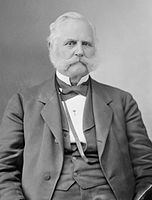November 5, 1878 1880 → 136 seats 0 seats 132 13 Start date June 3, 1878 | 157 seats 136 seats 148 132 9 4 | |
 | ||
Winner Samuel J Randall | ||
Elections to the United States House of Representatives were held in 1878 for Representatives to the 46th United States Congress. These elections occurred in the middle of President Rutherford B. Hayes's term.
Contents
- Election dates
- Colorado
- Florida
- Indiana
- Iowa
- Maine
- Maryland
- Massachusetts
- Minnesota
- Missouri
- Nebraska
- New Jersey
- New York
- South Carolina
- References
With a sour economy as the nation's pressing issue, both major parties lost seats to the new Greenback Party, which was established to promote the long-term use of paper money as a solution to stop enormous economic fluctuations. The Democratic Party remained the largest party, but lost its majority. However, it allied with several independent politicians and was able to remain in power. Notable freshmen included James B. Weaver, who would later run for president as the Greenback candidate in 1880 and the Populist candidate in 1892. This was the fourth and last recorded House election where both major parties lost seats at the same time.
Election dates
In 1845, Congress passed a law providing for a uniform nationwide date for choosing Presidential electors. This law did not affect election dates for Congress, which remained within the jurisdiction of State governments, but over time, the States moved their Congressional elections to this date as well. In 1878–79, there were still 7 states with earlier election dates, and 1 state with a later election date:
California's elections were the last time that a state held congressional general elections after November.
Colorado
Patterson successfully contested the election and was seated March 4, 1877.
Florida
In the 2nd district the difference between the two candidates, in the initial returns, was just 22 votes. Bisbee challenged Hull's election, and was eventually awarded the seat on January 22, 1881.
Indiana
In Indiana 7, Gilbert De La Matyr was also endorsed by the state Democratic Party.
Iowa
In Iowa 6, James B. Weaver was also endorsed by the state Democratic Party.
In Iowa 7, Edward H. Gillette was also endorsed by the state Democratic Party.
Maine
In Maine 4, George W. Ladd was also endorsed by the state Democratic Party.
Maryland
In Maryland 4, William Quigley was also endorsed by the state Greenback Party.
Massachusetts
In Massachusetts 5, Nathan Clark was also endorsed by the state Greenback Party.
In Massachusetts 11, Edward H. Lathrop was also endorsed by the state Greenback Party.
Minnesota
In Minnesota 1, William Meighan was also endorsed by the state Greenback Party.
In Minnesota 3, Ignatius L. Donnelly was also endorsed by the state Greenback Party.
Missouri
In Missouri 13, T. J. Fagg was also endorsed by the state Republican Party.
Nebraska
In the Nebraska At-Large District, J. W. Davis was also endorsed by the state Greenback Party.
New Jersey
In New Jersey 2, Hezekiah B. Smith was also endorsed by the state Greenback Party.
New York
In New York 2, Daniel O'Reilly was also endorsed by the state Republican Party.
In New York 5, Thomas Burke was also endorsed by the "Anti-Tammany" faction of the state Democratic Party.
In New York 6, Samuel S. Cox was endorsed by the state Greenback Party, and Maurice S. D'Vries was endorsed by the "Anti-Tammany" faction of the state Democratic Party.
In New York 8, Lawrence Jerome was also endorsed by the state Greenback Party.
In New York 10, James O'Brien was also endorsed by the state Republican Party. For the purposes of simplicity he is listed as having been elected an Independent Democrat.
In New York 23, John Spriggs was also endorsed by the state Greenback Party.
In New York 25, John Weiting was also endorsed by the state Greenback Party.
In New York 27, David Pierpont was also endorsed by the state Greenback Party.
South Carolina
South Carolina was one state rampant with voter fraud, particularly through the use of tissue ballots, thin ballots hidden in the normal ballot, typically 10 to 20 at a time. The almost statewide exclusion of Republicans as Commissioners of Elections, and the ensuing appointment of nearly all Democratic Managers of Elections, allowed to Democratic Managers to perpetrate this scheme. When the votes were counted and more votes than voters were found, the Managers removed and destroyed the Republican ballots resulting in the complete takeover of the state.
